Related Research Articles

A public utility company is an organization that maintains the infrastructure for a public service. Public utilities are subject to forms of public control and a regulation ranging from local community-based groups to statewide government monopolies.

A major appliance, or domestic appliance, is a large machine in home appliance used for routine housekeeping tasks such as cooking, washing laundry, or food preservation. An appliance is different from a plumbing fixture because it uses electricity or fuel.
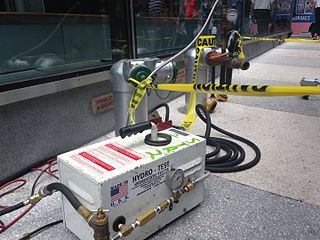
A hydrostatic test is a way in which pressure vessels such as pipelines, plumbing, gas cylinders, boilers and fuel tanks can be tested for strength and leaks. The test involves filling the vessel or pipe system with a liquid, usually water, which may be dyed to aid in visual leak detection, and pressurization of the vessel to the specified test pressure. Pressure tightness can be tested by shutting off the supply valve and observing whether there is a pressure loss. The location of a leak can be visually identified more easily if the water contains a colorant. Strength is usually tested by measuring permanent deformation of the container. Hydrostatic testing is the most common method employed for testing pipes and pressure vessels. Using this test helps maintain safety standards and durability of a vessel over time. Newly manufactured pieces are initially qualified using the hydrostatic test. They are then re-qualified at regular intervals using the proof pressure test which is also called the modified hydrostatic test. Testing of pressure vessels for transport and storage of gases is very important because such containers can explode if they fail under pressure.
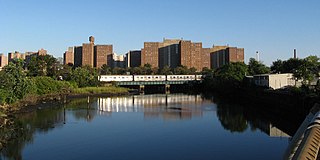
Coney Island Creek is a 1.8-mile-long (2.9 km) tidal inlet in Brooklyn, New York City. It used to be a 3-mile-long (4.8 km) continual strait and a partial mudflat connecting Gravesend Bay and Sheepshead Bay, making Coney Island an actual island, but the eastern half of the creek was filled in by land owners and city construction projects during a period spanning the early to mid 20th century.

Panamax and New Panamax are terms for the size limits for ships travelling through the Panama Canal. The limits and requirements are published by the Panama Canal Authority (ACP) in a publication titled "Vessel Requirements". These requirements also describe topics like exceptional dry seasonal limits, propulsion, communications, and detailed ship design.

A diving air compressor is a gas compressor that can provide breathing air directly to a surface-supplied diver, or fill diving cylinders with high-pressure air pure enough to be used as a breathing gas.
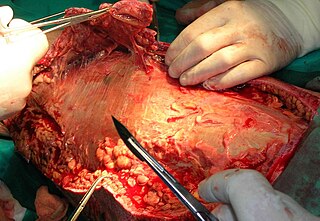
Debridement is the medical removal of dead, damaged, or infected tissue to improve the healing potential of the remaining healthy tissue. Removal may be surgical, mechanical, chemical, autolytic (self-digestion), and by maggot therapy.

In geography and fluvial geomorphology, a thalweg or talweg is the line of lowest elevation within a valley or watercourse.
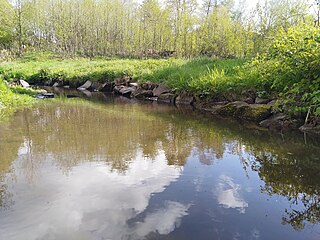
A body of water or waterbody is any significant accumulation of water, generally on a planet's surface. The term most often refers to oceans, seas, and lakes, but it includes smaller pools of water such as ponds, wetlands, or more rarely, puddles. A body of water does not have to be still or contained; rivers, streams, canals, and other geographical features where water moves from one place to another are also considered bodies of water.
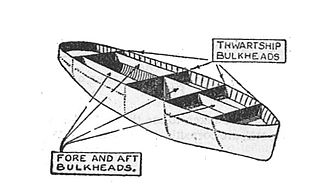
A bulkhead is an upright wall within the hull of a ship or within the fuselage of an aeroplane. Other kinds of partition elements within a ship are decks and deckheads.
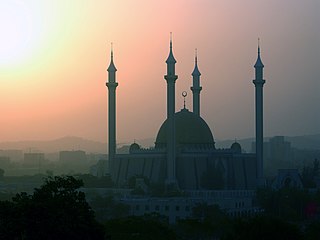
The Harmattan is a season in the West African subcontinent, which occurs between the end of November and the middle of March. It is characterized by the dry and dusty northeasterly trade wind, of the same name, which blows from the Sahara Desert over West Africa into the Gulf of Guinea. The name is related to the word haramata in the Twi language. The temperature is cold in most places, but can also be hot in certain places, depending on local circumstances.

Biosolids are solid organic matter recovered from a sewage treatment process and used as fertilizer. In the past, it was common for farmers to use animal manure to improve their soil fertiliy. In the 1920s, the farming community moved from animal manure to using local wastewater treatment plants. It is through years of research, scientists confirmed that these biosolids contained similar nutrients to that of regular cow manure. All biosolids that are used as fertilizer in the farming community is usually treated to prevent diseases and other pathogens from spreading to the public.

Cow dung, also known as cow pats, cow pies or cow manure, is the waste product of bovine animal species. These species include domestic cattle ("cows"), bison ("buffalo"), yak, and water buffalo. Cow dung is the undigested residue of plant matter which has passed through the animal's gut. The resultant faecal matter is rich in minerals. Color ranges from greenish to blackish, often darkening soon after exposure to air.

La Brea is a town in southwestern Trinidad, located northeast of Point Fortin and southwest of San Fernando. La Brea . is best known as the site of the Pitch Lake, a natural asphalt lake. Pronunciation of "La Brea" differs from that used in the USA at the La Brea Tar Pits in Los Angeles. Trinidadians call this place "La Bray."

A macaron or French macaroon is a sweet meringue-based confection made with egg white, icing sugar, granulated sugar, almond meal, and food colouring. There is some variation in whether the term macaron or macaroon is used, and the related coconut macaroon is often confused with the macaron. In North America, most bakers have adopted the French spelling of macaron for the meringue-based item to distinguish the two. Stanford professor of linguistics Daniel Jurafsky describes how the two confections have a shared history with macaroni. Jurafsky notes that French words ending with "-on" that were borrowed into English in the 16th and 17th centuries are usually spelled with "-oon". In the UK, many bakeries continue to use the term "macaroon".

The eaves are the edges of the roof which overhang the face of a wall and, normally, project beyond the side of a building. The eaves form an overhang to throw water clear of the walls and may be highly decorated as part of an architectural style, such as the Chinese dougong bracket systems.

The Mississippi Sound is a sound along the Gulf Coast of the United States. It runs east-west along the southern coasts of Mississippi and Alabama, from Waveland, Mississippi, to the Dauphin Island Bridge, a distance of about 145 kilometers (90 mi). The sound is bordered on its southern edge by the barrier islands - Cat, Ship, Horn, West Petit Bois, Petit Bois, and Dauphin. Ship, Horn, West Petit Bois and Petit Bois Islands are part of the National Park Service's Gulf Islands National Seashore. Those islands separate the sound from the Gulf of Mexico. The sediment of the islands was created partly by the ancient Mississippi River when the St. Bernard Lobe of the Mississippi Delta was active over two thousand years ago. The expansion of the St. Bernard subdelta slowly isolated the Mississippi Sound from ocean dynamics of the open Gulf of Mexico.

A bridle path, also bridleway, equestrian trail, horse riding path, ride, bridle road, or horse trail, is a path, trail or a thoroughfare that is used by people riding on horses. Trails originally created for use by horses often now serve a wider range of users, including equestrians, hikers, and cyclists. Such paths are either impassable for motorized vehicles, or vehicles are banned. The laws relating to allowable uses vary from country to country.

Sand is a granular material composed of finely divided rock and mineral particles. It is defined by size, being finer than gravel and coarser than silt. Sand can also refer to a textural class of soil or soil type; i.e., a soil containing more than 85 percent sand-sized particles by mass.

The South Boston Naval Annex, was a 167-acre (68 ha) United States Navy shipyard annex located in South Boston. It was the annex of the Boston Navy Yard, and was operational from the 1920 to 1974, when it was closed along with the main shipyard. The annex is also home to Dry Dock Number 3, the one of the largest dry docks on the East Coast.
References
- ↑ Warner, Sara (2007). "Down to the Waterline: Boundaries, Nature, and the Law in Florida". University of Georgia Press. p. 38. Retrieved 29 April 2014.
- ↑ "Bulkhead Line". Merriam-Webster.com. Merriam-Webster. Retrieved 29 April 2014.
| This legal term article is a stub. You can help Wikipedia by expanding it. |
| This article relating to topography is a stub. You can help Wikipedia by expanding it. |
| This hydrology article is a stub. You can help Wikipedia by expanding it. |

